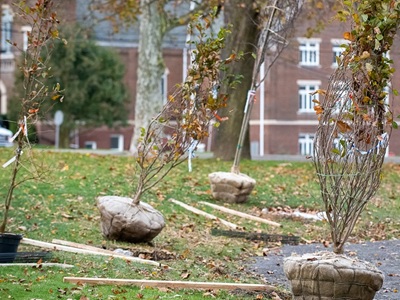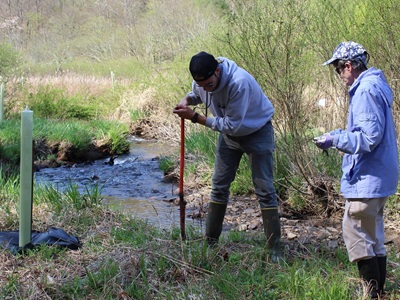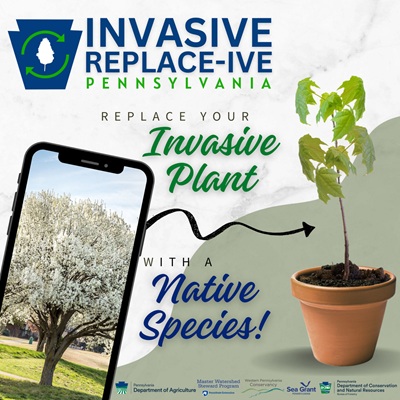Did someone say “Free trees”?
We did! The Western Pennsylvania Conservancy offers trees at no cost for urban communities to plant in public spaces, or for landowners to plant along streams or replace invasive trees or shrubs.
Urban Trees for Communities
Working in partnership with community groups, nonprofits and municipal agencies, TreeVitalize Pittsburgh, of which the Conservancy is managing partner, plants trees at no cost in Allegheny County municipalities, Pittsburgh neighborhoods and several towns throughout Western Pennsylvania.
Pittsburgh, of which the Conservancy is managing partner, plants trees at no cost in Allegheny County municipalities, Pittsburgh neighborhoods and several towns throughout Western Pennsylvania.
In urban areas, trees provide multiple benefits, including:
- providing shade and helping to cool heat islands
- increasing traffic to business districts and raising home values
- mitigating stormwater runoff and filtering pollutants before they can enter waterways
- providing food and habitat for birds, small wildlife and beneficial insects.
Just some species of trees available include oaks, dogwoods, magnolias and Kentucky coffeetrees.
Community groups or municipalities can apply during spring for trees to be planted the following fall, or during fall for the following spring, along streets and trails, in community parks and for restoration. TreeVitalize Pittsburgh provides forestry expertise, trees, supplies and planting event coordination for neighborhood groups. Learn more about getting free trees through Treevitalize and apply here.
Native Riparian Trees for Landowners
 We love working with farmers and landowners to improve water quality! Part of that work includes planting streamside, or riparian, trees. Landowners with streamside acreage can apply through June 2027 to get free riparian trees planted through the Conservancy’s Riparian Restoration Tree Planting Initiative.
We love working with farmers and landowners to improve water quality! Part of that work includes planting streamside, or riparian, trees. Landowners with streamside acreage can apply through June 2027 to get free riparian trees planted through the Conservancy’s Riparian Restoration Tree Planting Initiative.
Riparian trees improve water quality and wildlife habitat by:
- stabilizing streambanks
- reducing sedimentation
- cooling water temperatures
- filtering pollutants such as excess nitrogen and phosphorus
- providing food and habitat for birds and small wildlife.
Some native tree species available include oaks, maples, hickory, sycamore, dogwoods and willows. Funding is provided by the PA DCNR Community Conservation Partnership Program (C2P2) to plant riparian buffers throughout western and central Pennsylvania. Learn about the Riparian Restoration Tree Planting Initiative, including how to qualify, and complete a short application here.
Native Trees to Replace Invasives
The Conservancy is a partner of the Pennsylvania Invasive Replace-ive Program. Established in 2025, the initiative gives homeowners and others the option to remove invasive trees and shrubs and replace them with native trees. This reduces the likelihood of the invasive species spreading to neighboring properties, parks and forests.
the initiative gives homeowners and others the option to remove invasive trees and shrubs and replace them with native trees. This reduces the likelihood of the invasive species spreading to neighboring properties, parks and forests.
Invasive species
- compete directly with native species for space and resources
- significantly alter habitats that other species depend upon
- can impact the economy by clogging marinas, outcompeting agricultural crops, introducing disease into our forests or overrunning yards, parks and other public spaces.
Common invasive species include Callery pear, burning bush, barberry, tree-of-heaven, Norway maple and butterfly bush.
Native trees:
- help diversify the urban landscape
- provide food and shelter for native birds, insects and wildlife
- have adapted to the environment where they naturally grow.
Property owners can remove one or more invasive species and receive up to five free, healthy, native, young replacement trees. Species available vary by location, but include redbud, serviceberry, shagbark hickory, white oak, persimmon and more.
This popular initiative offers several locations for native tree pickup throughout the state during May. Please note: All locations in 2025 currently have wait lists. Watch for announcements in 2026. Learn more about the PA Invasive Replac-ive Program and how to register here.
